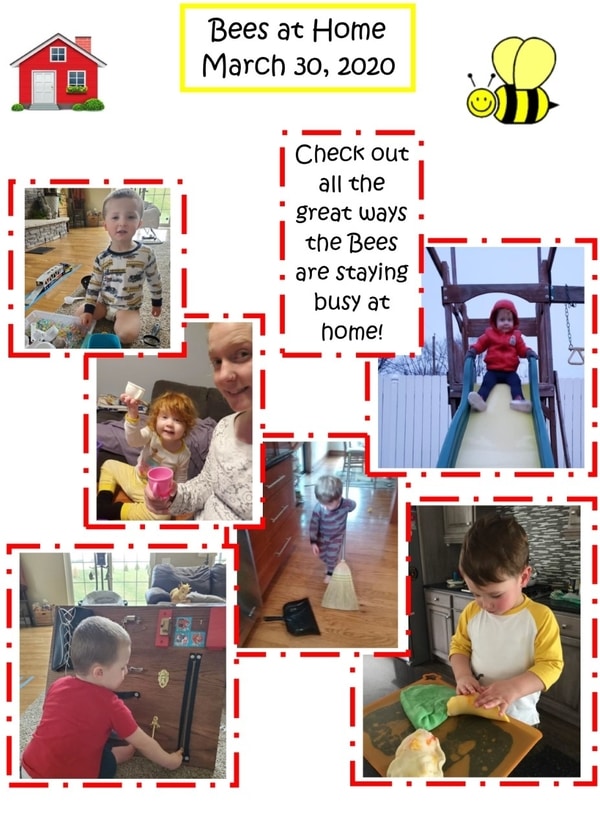Newsletters bridge social divide between CLC staff, children
Tuesday, March 31, 2020
As Penn College faculty find unique ways to teach their students remotely, teachers in the college’s Dunham Children’s Learning Center are keeping their young charges engaged from a distance, too.
“Each day, the teachers are sending an email to families with a suggested activity,” explained Barbara J. Albert, director of the children’s learning center. “The families are sending back photos of the children. The teachers then create a 'newsletter' which is shared with the families.”
 A “Here’s What We Did Today” e-newsletter detailing activities through photos and captions is a tradition in the Children’s Learning Center. Now called “Bunnies at Home” or “Bees at Home,” the continued newsletter is providing “lots of meaningful connections” while the staff and children must keep a distance from one another.
A “Here’s What We Did Today” e-newsletter detailing activities through photos and captions is a tradition in the Children’s Learning Center. Now called “Bunnies at Home” or “Bees at Home,” the continued newsletter is providing “lots of meaningful connections” while the staff and children must keep a distance from one another.
Other efforts include a toddler teacher recording herself reading a book and sending it to the children, while another teacher is holding a virtual “circle time” each morning at 11 o’clock using Zoom.
“Children are vulnerable to the emotional impact of events that disrupt their daily lives,” Albert explained. “Even toddlers and preschoolers may struggle with significant adjustments to their routines. Most children will return to their typical functioning after the crisis when they receive consistent support from caregivers during the crisis. The teachers are trying to help families provide that support to their children by giving them specific ideas such as inside scavenger hunts, science experiments or art activities.”
Teachers have also sent links to resources.
Parents have responded appreciatively to the staff’s efforts.
“With the struggles our world is facing right now, it is wonderful to see the communication continue,” said Kali M. Farnsworth, a Penn College student whose child is enrolled at the Children’s Learning Center. “For my son, it has been amazing having his teachers send pictures, activity ideas, video chat, and constantly keep that communication open.”
Albert further explained the value: “As families share photos with one another, the children can see that their friends are safe. During the virtual circle times, the children sing, dance and giggle with delight. These positive experiences help the children realize their teachers care about them even if they can't be together physically.”
A few tips, as shared by the Children’s Learning Center:
If you have children at home
Dealing with the here and now
“Each day, the teachers are sending an email to families with a suggested activity,” explained Barbara J. Albert, director of the children’s learning center. “The families are sending back photos of the children. The teachers then create a 'newsletter' which is shared with the families.”
 A “Here’s What We Did Today” e-newsletter detailing activities through photos and captions is a tradition in the Children’s Learning Center. Now called “Bunnies at Home” or “Bees at Home,” the continued newsletter is providing “lots of meaningful connections” while the staff and children must keep a distance from one another.
A “Here’s What We Did Today” e-newsletter detailing activities through photos and captions is a tradition in the Children’s Learning Center. Now called “Bunnies at Home” or “Bees at Home,” the continued newsletter is providing “lots of meaningful connections” while the staff and children must keep a distance from one another.Other efforts include a toddler teacher recording herself reading a book and sending it to the children, while another teacher is holding a virtual “circle time” each morning at 11 o’clock using Zoom.
“Children are vulnerable to the emotional impact of events that disrupt their daily lives,” Albert explained. “Even toddlers and preschoolers may struggle with significant adjustments to their routines. Most children will return to their typical functioning after the crisis when they receive consistent support from caregivers during the crisis. The teachers are trying to help families provide that support to their children by giving them specific ideas such as inside scavenger hunts, science experiments or art activities.”
Teachers have also sent links to resources.
Parents have responded appreciatively to the staff’s efforts.
“With the struggles our world is facing right now, it is wonderful to see the communication continue,” said Kali M. Farnsworth, a Penn College student whose child is enrolled at the Children’s Learning Center. “For my son, it has been amazing having his teachers send pictures, activity ideas, video chat, and constantly keep that communication open.”
Albert further explained the value: “As families share photos with one another, the children can see that their friends are safe. During the virtual circle times, the children sing, dance and giggle with delight. These positive experiences help the children realize their teachers care about them even if they can't be together physically.”
A few tips, as shared by the Children’s Learning Center:
If you have children at home
- Focus on washing hands properly
- Set up virtual play dates
- Spend extra time playing with your children
- Create a cozy, safe retreat
- Expect behavioral issues and respond gently
- Focus on safety and attachment
- Avoid social media and COVID-19 conversation around children
- Go outside, run with them
Dealing with the here and now
- Stick to a routine
- Go for a walk
- Maintain social contact
- Understand those around you
- Limit social media/TV around COVID-19
- Counterbalance the heavy information with the hopeful information
- Do something you never feel you have the time to do
- Reach out for help
- Help others
- Remind yourself daily that this is temporary
From "Understanding the Impact of Trauma on Behavior" by Barbara Kaiser,
sponsored by Early Childhood Investigations Webinars
